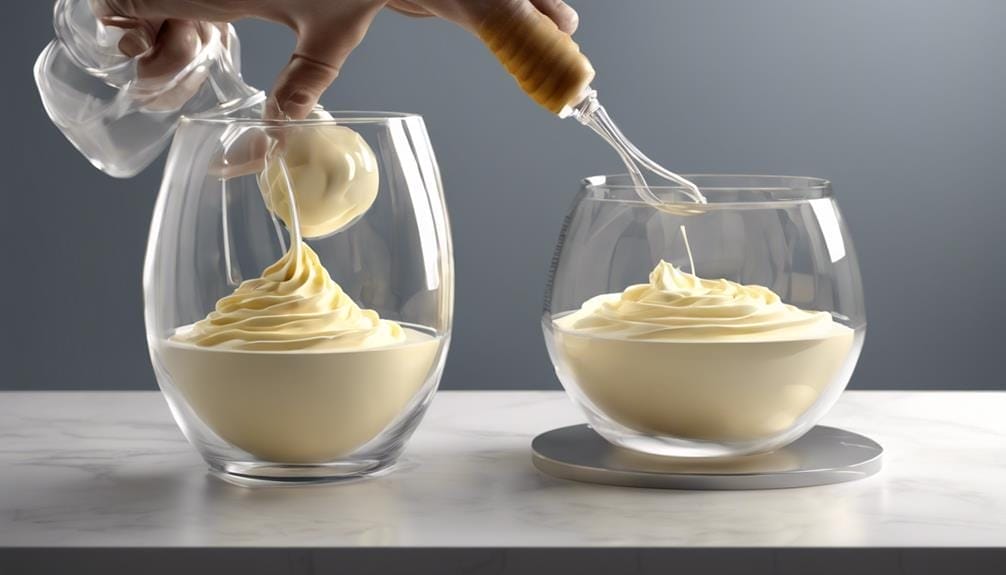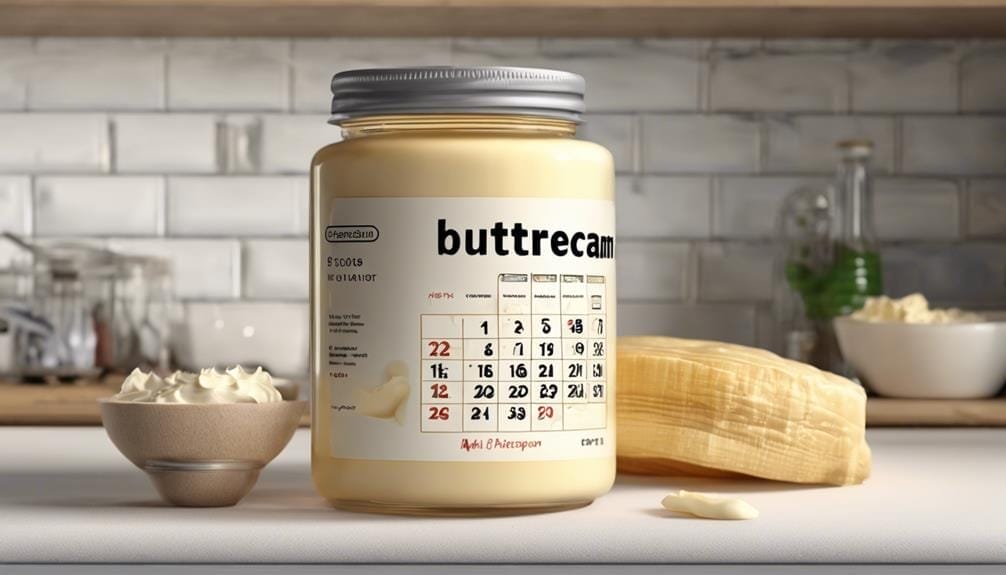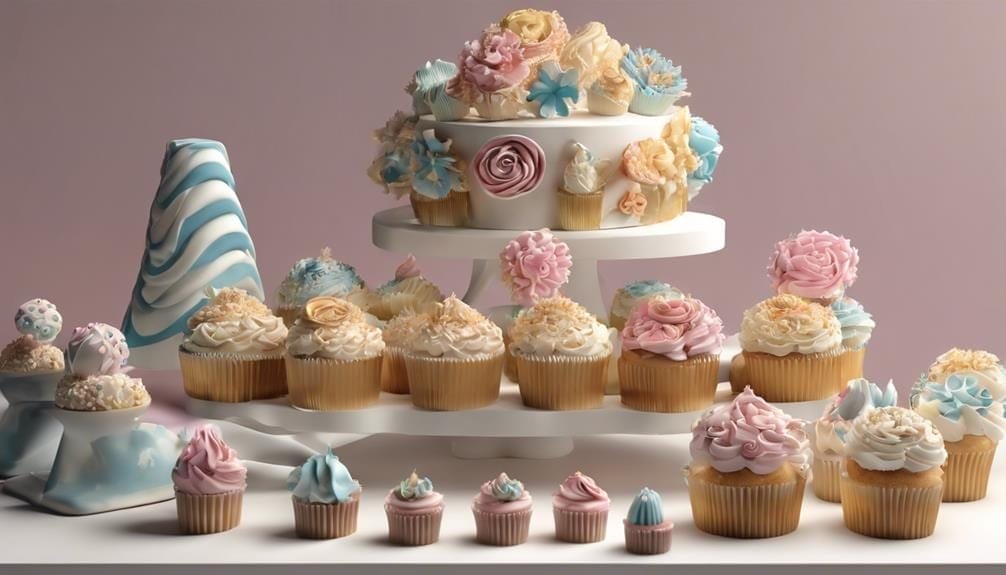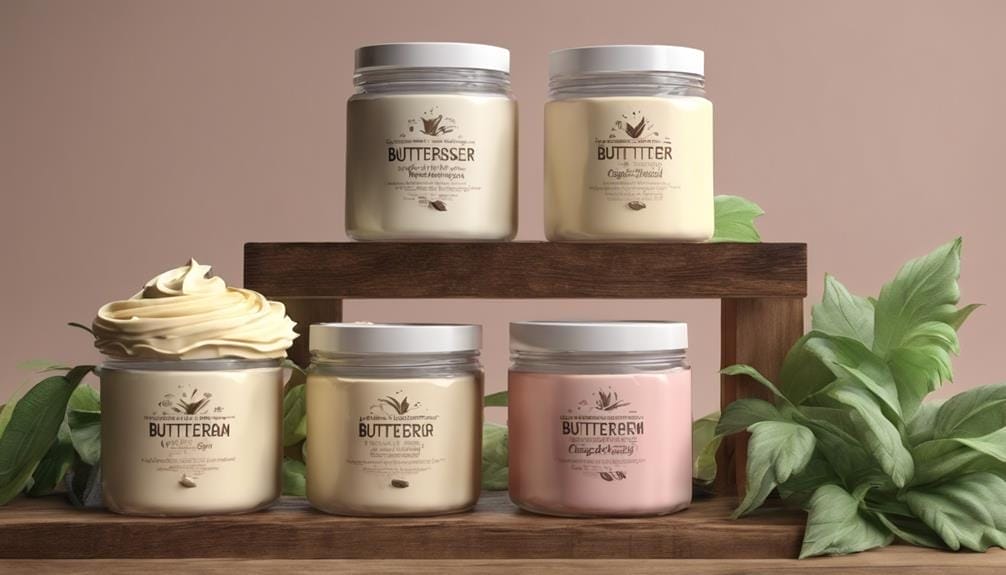When considering shelf-stable buttercream, keep in mind that it's easy to create with basic ingredients like butter, sugar, vanilla, cream, and salt. You'll need standard kitchen tools like a mixer, bowls, and measuring utensils for preparation. Start by blending soft butter with sugar gradually, adding in vanilla, salt, and cream. Store in an airtight container for up to 7 days at room temperature; the high sugar content acts as a preservative. Experiment with different flavors like chocolate, strawberry, lemon, or coffee for customization. For more on options, vegan or nut-free alternatives, and tips on enhancing stability, explore the possibilities.
Ingredients
To make shelf-stable buttercream, you'll need a few key ingredients. Butter is the foundation of the frosting, providing richness and flavor. Powdered sugar is vital for adding sweetness and structure to the buttercream, helping it hold its shape. Vanilla extract enriches the overall taste profile, giving the buttercream a delightful aroma. Heavy cream plays an important role in adjusting the consistency of the frosting, ensuring it's smooth and spreadable. Finally, salt is added to balance the sweetness and enhance the flavor of the buttercream to new heights.
When combined in the right proportions, these ingredients create a luscious and stable buttercream that can withstand varying temperatures without melting or losing its shape.
Perfect for decorating cakes, cupcakes, or cookies, this shelf-stable buttercream is a versatile and delicious enhancement to any baker's repertoire.
Equipment Needed
For preparing the shelf-stable buttercream, you'll require specific equipment to guarantee a smooth and efficient mixing process. Here are the crucial tools you'll need:
- Stand Mixer: A stand mixer is ideal for effortlessly blending the ingredients together to create a silky smooth buttercream frosting.
- Mixing Bowls: Having a range of mixing bowls in different sizes will make it easier to mix different amounts of frosting and ensure thorough incorporation of ingredients.
- Measuring Cups and Spoons: Accurate measurements are key to achieving the perfect balance of ingredients in your buttercream, so make sure you have these on hand.
- Spatula: Use a spatula to scrape down the sides of the mixing bowl, ensuring all ingredients are evenly combined for a consistent texture in your buttercream.
Having these tools ready will set you up for success when making your shelf-stable buttercream frosting at home.
Mixing Instructions

How can you achieve a creamy consistency when mixing your shelf-stable buttercream?
For a successful buttercream recipe, start by ensuring your butter is at room temperature. This step is essential in achieving a smooth texture.
Using a stand mixer, gradually add powdered sugar to the butter while mixing to prevent clumps in your buttercream. The slow incorporation helps create a homogeneous mixture.
To improve the flavor profile of your buttercream, incorporate vanilla extract and a pinch of salt, balancing the sweetness with a hint of saltiness.
If you find your buttercream too thick, adjust the consistency by adding heavy cream in small increments until you reach your desired texture. The heavy cream will help lighten the frosting while maintaining its stability.
Storing Buttercream
Achieving a creamy consistency in your shelf-stable buttercream is just the beginning; now, let's investigate the best ways to store this versatile frosting.
When it pertains to storing your frosting recipe, consider the following tips:
- Room Temperature: Shelf-stable buttercream can be stored at room temperature for up to 7 days due to its high sugar content, making it ideal for outdoor events like weddings or markets without refrigeration.
- Versatility: Room temperature storage ensures stable frosting even in warm weather conditions, providing convenience and flexibility for different baking needs.
- Diversity: Proper ingredients and techniques are essential to guarantee the longevity and stability of shelf-stable buttercream frosting.
- Convenience: With the ability to be stored at room temperature, this type of buttercream offers convenience without compromising on taste or texture.
Shelf Life

To guarantee maximum freshness, store your shelf-stable buttercream in an airtight container at room temperature for up to 7 days. This extended shelf life is made possible by the high sugar content in the buttercream, which acts as a natural preservative.
When properly sealed, your buttercream will maintain its quality and texture throughout this period, making it a convenient option for events like outdoor weddings or farmers markets where refrigeration may not be available.
The combination of ingredients like cream cheese and powdered sugar in shelf-stable buttercream contributes to its longevity without compromising on taste or consistency. This feature ensures that your frosting will remain stable even in warm weather conditions, offering you flexibility and ease of use for different baking needs.
Flavor Variations
To enhance the versatility of your shelf-stable buttercream, consider exploring different flavor options such as chocolate, strawberry, lemon, coffee, and almond to cater to different tastes and occasions. Here are some exciting flavor variations to boost your buttercream recipe:
- Chocolate Buttercream: Add a decadent cocoa flavor to your buttercream for a rich and indulgent twist.
- Strawberry Buttercream: Infuse your buttercream with the fruity sweetness of strawberries for a revitalizing taste.
- Lemon Buttercream: Incorporate zesty lemon extract into your buttercream for a tangy and citrusy flavor profile.
- Coffee Buttercream: For coffee lovers, try adding a hint of coffee flavor to your buttercream for a bold and aromatic experience.
Experimenting with these flavor variations can transform your shelf-stable buttercream, making it perfect for a wide range of desserts and occasions.
Whether you're baking for a birthday party or a casual gathering, these diverse flavor options will surely impress your guests.
Decorating Tips

Consider using a piping bag and a range of tips to create different frosting designs and textures for your shelf-stable buttercream decorations. The piping bag allows for precise application of the frosting, making it easier to achieve intricate designs.
Experiment with different tips to create different effects such as rosettes, shells, swirls, and ruffles. By changing the tip, you can alter the texture and appearance of your frosting, adding visual interest to your desserts.
To boost the visual appeal of your decorations, consider incorporating food coloring to achieve vibrant or pastel-colored buttercream. Moreover, you can add sprinkles, edible glitter, or fondant decorations to further enhance the look of your frosted treats.
After decorating, remember to chill your desserts briefly to help the buttercream set and maintain its shape. These decorating tips won't only make your treats visually appealing but also showcase your creativity and attention to detail.
Troubleshooting
When troubleshooting shelf-stable buttercream, you must address issues related to consistency, flavor, and stability. Here are some tips to help you overcome common buttercream challenges:
- Grainy Texture: If your buttercream feels grainy, try sifting your powdered sugar before adding it to the mixture. This can help prevent clumps and guarantee a smoother texture.
- Greasy Feel: To combat a greasy sensation in your buttercream, make sure your butter is at the right temperature before mixing. Softened but not melted butter is key to achieving a creamy, non-greasy consistency.
- Lack of Stability in Warm Weather: If your buttercream is melting or losing shape in warm conditions, consider adjusting the ratio of butter to sugar. A higher sugar content can help stabilize the buttercream in higher temperatures.
- Storage: Store your buttercream in an airtight container in a cool, dry place to maintain its freshness and consistency, especially when dealing with cottage foods regulations.
Vegan Options

For creating vegan buttercream, you can swap out dairy butter with plant-based margarine or shortening. By making this simple substitution, you can enjoy a delicious and cruelty-free frosting that is perfect for vegans or those with dairy allergies. Furthermore, plant-based milk, such as almond, soy, or coconut milk, can replace dairy milk in vegan buttercream recipes, ensuring that every component is free from animal products. To help you understand the differences between traditional and vegan buttercream, take a look at the table below:
| Ingredient | Traditional Buttercream | Vegan Buttercream |
|---|---|---|
| Dairy Butter | Used | Replaced with margarine/shortening |
| Dairy Milk | Used | Replaced with plant-based milk |
| Eggs | Used | Avoided |
Nut-Free Alternatives
You can easily swap out butter for vegetable shortening or coconut oil to create nut-free buttercream frosting. Here are some tips for making nut-free alternatives:
- Choose the Right Fat: Vegetable shortening and coconut oil are excellent substitutes for butter in nut-free buttercream frosting recipes.
- Explore Dairy-Free Options: Use milk alternatives like almond milk, soy milk, or oat milk in your nut-free buttercream to cater to dairy restrictions.
- Enhance Flavors: Add extracts such as vanilla, almond, or citrus to enhance the taste of your nut-free buttercream without relying on nuts.
- Read Labels Thoroughly: Make sure all ingredients, including flavorings and decorations, are nut-free by carefully checking labels to prevent cross-contamination.
Frequently Asked Questions
Is Buttercream Considered Shelf Stable?
Yes, buttercream preservation is possible due to its high sugar content which acts as a preservative. At room temperature, it can be stored for up to 7 days without refrigeration. This makes it convenient for different baking needs.
Which Buttercream Is the Most Stable?
When considering buttercream stability, American buttercream reigns as the most stable option. It offers the best shelf life among buttercreams due to its high sugar content. For a reliable choice, American buttercream is your go-to.
What Kind of Icing Does Not Need to Be Refrigerated?
For icing that doesn't need refrigeration, American buttercream is your best bet. It can sit at room temperature for up to 7 days, making it a convenient and long-lasting frosting option. Enjoy the stability without the fridge hassle.
Is There a Cream Cheese Frosting That Doesn't Need to Be Refrigerated?
For a cream cheese frosting that doesn't need refrigeration, consider cream cheese alternatives and room temperature frosting recipes. Some formulations use stabilizers or alternative ingredients for safe storage outside the fridge. Follow specific instructions for best results.
Conclusion
To sum up, shelf stable buttercream is a versatile and convenient option for decorating and storing baked goods. With the right ingredients and equipment, you can easily whip up a batch of this delicious frosting to have on hand whenever you need it.
By following the mixing instructions and storing it properly, you can guarantee your buttercream lasts for weeks. Experiment with different flavors and decorating techniques to create stunning desserts that will impress your friends and family.
Enjoy baking!